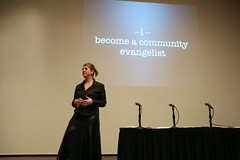Illustration by Noma Bar The Economist (you know by now my passionate feelings for this publication, oh loyal grep le miette audience) released their special report on Innovation in the October 13th issue. It is wonderful.
The Economist (you know by now my passionate feelings for this publication, oh loyal grep le miette audience) released their special report on Innovation in the October 13th issue. It is wonderful.
a few gems for you, gentle reader:
1) get better at fast failing: "Harold Sirkin, of the Boston Consulting Group, is the co-author of “Payback”, a book on innovation strategy. He scoffs that “firms have too many ideas and too much emphasis on creativity—more ideas merely choke the funnel even more.” In fact, the more ideas a firm comes up with, the more important it is for bosses to decide early on which of them to kill off. This is to avoid heading down countless and costly dead ends. As Ron Adner of Insead, a French business school, puts it, “Innovation is a loser's game, as we know most initiatives fail. But the truly innovative companies know how to deal with losing.”
That is why failing fast and learning from those failures is so important for companies. Niklas Savander, of Nokia, argues that given today's accelerating pace of global innovation firms “need really harsh discipline to weed out ideas quite quickly—we are working at fast failing, but are not there yet.”
2) Turf wars are another obstacle to fast failing. Employees in one part of a company often reject ideas and advice from a different part. Mark Little, GE's head of research, confesses that getting his boffins to kill off unviable projects is the hardest task he faces: “Like a dog with a bone, people don't want to give them up.”
3) Peter Drucker, an eminent management guru, argued decades ago that innovation and entrepreneurship are “purposeful tasks that can be organised—are in need of being organised” and should be treated as part of an executive's job.
4) Giant Toyota enables innovation with the Prius hybrid-electric car. "It was a risky bet on an unproven technology, but it has been a huge success. It was a long-term vision, says Mr Reinert, that overcame the firm's innate caution. And in the future the company is going to have to make similar bets again. 'We are convinced that we are entering a disruptive future, and we want to be ready for it,' he says."
5) Even if firms can overcome the stigma of failure, how exactly are bosses to know which potential innovations to kill? Clayton Christensen, author of “The Innovator's Dilemma”, believes he has cracked the code. He says it can require unlearning some of the things that managers often accept as golden rules. The chief one is the belief in listening and responding to the needs of your best customers.
This seemingly sensible strategy can be a dangerous siren song, Mr Christensen argues. His influential book shows how even successful firms can get into trouble by trying to please their best customers. Because there may be only a handful of highly profitable, high-end buyers who want and can afford more features and better performance, firms can invest heavily in trying to deliver what this elite group wants even though the resulting products may end up beyond the reach of the majority of their customers.
That, argues Mr Christensen, allows upstarts to enter the market and offer inferior (although perfectly adequate) technologies and products at much cheaper prices and push incumbents into ever smaller niches—and ultimately out of business altogether. He cautions this “disruptive” innovation is not the same thing as “radical” or “breakthrough” innovation, although the notions are often conflated.
6) Clustering is still where it's at: "It is not much of an exaggeration to say that, aside from mobile telephony, Europe has not come up with a globally disruptive innovation in decades—although Skype, an internet-telephony firm that is now part of eBay, once looked like it might qualify."
7) Incrementalism can be the enemy of radical change: "Visit Wal-Mart's headquarters in Bentonville, Arkansas, and you will be greeted by a large plaque in the lobby which says: 'Incrementalism is innovation's worst enemy! We don't want continuous improvement, we want radical change. .'.. But ask Linda Dillman, a senior official at the firm, about innovation at Wal-Mart today and she concedes that radical thinking was easier when the firm was young. Meg Whitman, eBay's boss, says the same. She concentrates on incremental improvement within the online auctioneer while looking outside to acquire radical ideas by buying start-up companies, including ones in other markets that imitate eBay."
Labels: claytonchristensen, disruptive innovation, ebay, innovation, the economist
 after reading about penny's surprising test results on leslie's blog, i am so getting this done for stella. after all if dna testing can prove that barack obama and dick cheney are related, i'm certain i can turn up something fun on our pup.
after reading about penny's surprising test results on leslie's blog, i am so getting this done for stella. after all if dna testing can prove that barack obama and dick cheney are related, i'm certain i can turn up something fun on our pup.
 The Economist (you know by now my passionate feelings for this publication, oh loyal grep le miette audience) released their
The Economist (you know by now my passionate feelings for this publication, oh loyal grep le miette audience) released their 

